Numbers in Chinese – My Guide
In this guide, I will start by giving beginners a useful guide to Chinese numbers, then I’ll provide some references for translators.
Chinese numbers are very easy for the most part, if you learn from 1 to 10, you can then calculate numbers right up to 99, then if you add the word 100 you can get up to 999, and so on. However for translators, there are some nasty surprises in formal documents like bank statements or contracts which are not covered in any academic textbooks.
In Chinese texts, there’s nothing to stop writers using our familiar English numbers (I’m aware they are actually Arabic, but I think the term “English numbers” is clearer). If that happens, be warned that they won’t be included in Asian word counts done with most software. See my article on Word Counts for more information about that.
Part 1 – Easy Chinese Numbers
Chinese numbers from zero to ten
Chinese numbers from 1-10 couldn’t be much easier. There is one character per number, except for the number for “0” which is commonly written in two ways: The character for zero is often just written with a big circle character 〇 as well as with the formal character 零. As an aside I used to believe that the 〇 character was derived from the English 0 but actually it’s the other way round. The English 0 is derived from an Indian version of 〇.
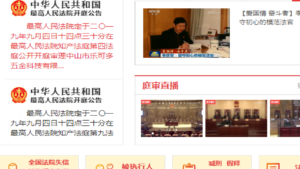
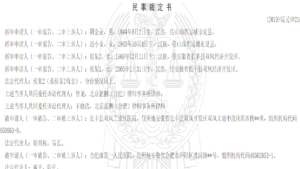
Some exceptions
List of Chinese numbers from zero to ten
| English number | Simplified Chinese character | Traditional Chinese character | Hanyu pinyin pronunciation | English pronunciation guide |
|---|---|---|---|---|
| 00 | 〇 / 零 | 〇 / 零 | ling2 | "Ling" (like link with a g instead of k) |
| 1 | 一 | 一 | yi1 | "Eeee" (rhymes with me) |
| 2 | 二 | 二 | er4 | "Eeer" (like "her" without the h) |
| 3 | 三 | 三 | san1 | "Saaaan" (like "sand" without the d) |
| 4 | 四 | 四 | si4 | "Ser" (rhymes with her, but with a very soft "r" sound) |
| 5 | 五 | 五 | wu3 | "Wooo" (woo-hoo!) |
| 6 | 六 | 六 | liu4 | "Li-ooo" |
| 7 | 七 | 七 | Qi1 | "Che" (like "cheese" without the "se") |
| 8 | 八 | 八 | Ba1 | "Ba" (like a black sheep!) |
| 9 | 九 | 九 | Jiu3 | "Geee-ooo" (Like "gee-wizz, ooo-ah Cantona) |
| 10 | 十 | 十 | Shi2 | "Shi" (rhymes with her but with a soft "r") |
Once you get to ten, just put ten in front of any other number to make numbers from 11 to 19. For example “15” is just written as “Ten Five”, 18 is written as “Ten Eight”.
| English number | Simplified Chinese number | Traditional Chinese number | Hanyu pinyin | Comments |
|---|---|---|---|---|
| 11 | 十一 | 十一 | Shi2yi1 | Note that these numbers are rolled into one without a space; not Shi Yi, but Shiyi1 |
| 12 | 十二 | 十二 | Shi2er4 | |
| 13 | 十三 | 十三 | Shi2san1 | |
| 14 | 十四 | 十四 | Shi2si4 | |
| 15 | 十五 | 十五 | Shi2wu3 | |
| 16 | 十六 | 十六 | Shi2liu4 | |
| 17 | 十七 | 十七 | Shi2qi1 | |
| 18 | 十八 | 十八 | Shi2ba1 | |
| 19 | 十九 | 十九 | Shi2jiu3 |
Chinese numbers from twenty to ninety-nine
Twenty is also very easy, just say “Two Ten”, twenty one is then “Two Ten One” and so on. That gets us all the way up to 99.
| English number | Simplified Chinese number | Traditional Chinese number | Hanyu pinyin | Comments |
|---|---|---|---|---|
| 20 | 二十 | 二十 | Er4shi2 | Again, note how the pinyin for these characters is written without spaces |
| 21 | 二十一 | 二十一 | Er4shi2yi1 | |
| 22 | 二十二 | 二十二 | Er4shi2er4 | |
| 23 | 二十三 | 二十三 | Er4shi2san1 | |
| 24 | 二十四 | 二十四 | Er4shi2si4 | |
| 25 | 二十五 | 二十五 | Er4shi2wu3 | |
| 26 | 二十六 | 二十六 | Er4shi2liu4 | |
| 27 | 二十七 | 二十七 | Er4shi2qi1 | |
| 28 | 二十八 | 二十八 | Er4shi2ba1 | |
| 29 | 二十九 | 二十九 | Er4shi2jiu3 | |
| 30 | 三十 | 三十 | San1shi2 | |
| 31 | 三十一 | 三十一 | San1shi2yi1 | |
| 32 | 三十二 | 三十二 | San1shi2er4 | |
| 33 | 三十三 | 三十三 | San1shi2san1 | |
| 34 | 三十四 | 三十四 | San1shi2si4 | |
| 35 | 三十五 | 三十五 | San1shi2wu3 | |
| 36 | 三十六 | 三十六 | San1shi2liu4 | |
| 37 | 三十七 | 三十七 | San1shi2qi1 | |
| 38 | 三十八 | 三十八 | San1shi2ba1 | |
| 39 | 三十九 | 三十九 | San1shi2jiu3 | |
| 40 | 四十 | 四十 | Si4shi2 | |
| 41 | 四十一 | 四十一 | Si4shi2yi1 | |
| 42 | 四十二 | 四十二 | Si4shi2er4 | |
| 43 | 四十三 | 四十三 | Si4shi2san1 | |
| 44 | 四十四 | 四十四 | Si4shi2si4 | |
| 45 | 四十五 | 四十五 | Si4shi2wu3 | |
| 46 | 四十六 | 四十六 | Si4shi2liu4 | |
| 47 | 四十七 | 四十七 | Si4shi2qi1 | |
| 48 | 四十八 | 四十八 | Si4shi2ba1 | |
| 49 | 四十九 | 四十九 | Si4shi2jiu3 | |
| 50 | 五十 | 五十 | Wu3shi2 | |
| 51 | 五十一 | 五十一 | Wu3shi2yi1 | |
| 52 | 五十二 | 五十二 | Wu3shi2er4 | |
| 53 | 五十三 | 五十三 | Wu3shi2san1 | |
| 54 | 五十四 | 五十四 | Wu3shi2si4 | |
| 55 | 五十五 | 五十五 | Wu3shi2wu3 | |
| 56 | 五十六 | 五十六 | Wu3shi2liu4 | |
| 57 | 五十七 | 五十七 | Wu3shi2qi1 | |
| 58 | 五十八 | 五十八 | Wu3shi2ba1 | |
| 59 | 五十九 | 五十九 | Wu3shi2jiu3 | |
| 60 | 六十 | 六十 | Liu4shi2 | |
| 61 | 六十一 | 六十一 | Liu4shi2yi1 | |
| 62 | 六十二 | 六十二 | Liu4shi2er4 | |
| 63 | 六十三 | 六十三 | Liu4shi2san1 | |
| 64 | 六十四 | 六十四 | Liu4shi2si4 | |
| 65 | 六十五 | 六十五 | Liu4shi2wu3 | |
| 66 | 六十六 | 六十六 | Liu4shi2liu4 | |
| 67 | 六十七 | 六十七 | Liu4shi2qi1 | |
| 68 | 六十八 | 六十八 | Liu4shi2ba1 | |
| 69 | 六十九 | 六十九 | Liu4shi2jiu3 | |
| 70 | 七十 | 七十 | Qi1shi2 | |
| 71 | 七十一 | 七十一 | Qi1shi2yi1 | |
| 72 | 七十二 | 七十二 | Qi1shi2er4 | |
| 73 | 七十三 | 七十三 | Qi1shi2san1 | |
| 74 | 七十四 | 七十四 | Qi1shi2si4 | |
| 75 | 七十五 | 七十五 | Qi1shi2wu3 | |
| 76 | 七十六 | 七十六 | Qi1shi2liu4 | |
| 77 | 七十七 | 七十七 | Qi1shi2qi1 | |
| 78 | 七十八 | 七十八 | Qi1shi2ba1 | |
| 79 | 七十九 | 七十九 | Qi1shi2jiu3 | |
| 80 | 八十 | 八十 | Ba1shi2 | |
| 81 | 八十一 | 八十一 | Ba1shi2yi1 | |
| 82 | 八十二 | 八十二 | Ba1shi2er4 | |
| 83 | 八十三 | 八十三 | Ba1shi2san1 | |
| 84 | 八十四 | 八十四 | Ba1shi2si4 | |
| 85 | 八十五 | 八十五 | Ba1shi2wu3 | |
| 86 | 八十六 | 八十六 | Ba1shi2liu4 | |
| 87 | 八十七 | 八十七 | Ba1shi2qi1 | |
| 88 | 八十八 | 八十八 | Ba1shi2ba1 | |
| 89 | 八十九 | 八十九 | Ba1shi2jiu3 | |
| 90 | 九十 | 九十 | Jiu3shi2 | |
| 91 | 九十一 | 九十一 | Jiu3shi2yi1 | |
| 92 | 九十二 | 九十二 | Jiu3shi2er4 | |
| 93 | 九十三 | 九十三 | Jiu3shi2san1 | |
| 94 | 九十四 | 九十四 | Jiu3shi2si4 | |
| 95 | 九十五 | 九十五 | Jiu3shi2wu3 | |
| 96 | 九十六 | 九十六 | Jiu3shi2liu4 | |
| 97 | 九十七 | 九十七 | Jiu3shi2qi1 | |
| 98 | 九十八 | 九十八 | Jiu3shi2ba1 | |
| 99 | 九十九 | 九十九 | Jiu3shi2jiu3 |
Chinese numbers above one hundred
Now let’s just learn the words for bigger units and we can make the numbers easily by adding the appropriate numbers
| Number | Name in English | Number in SImplified Chinese | Number in Traditional Chinese | Pronunciation | Examples | Comments |
|---|---|---|---|---|---|---|
| 100 | Hundred | 百 | 百 | Bai3 | 300 = 三百 | Part of the "normal counting scale" both in English and Chinese, see below |
| 1,000 | Thousand | 千 | 千 | Qian1 | 9000 = 九千 | Part of the "normal counting scale" both in English and Chinese, see below |
| 10,000 | Ten Thousand | 万 | 萬 | Wan4 | 43,000 = 四万三千 | Part of the "normal counting scale" in Chinese, see below, not in English; by the way, did you know that the word "myriad" in English literally means "ten thousand"! |
| 100,000 | Hundred Thousand | 十万 | 十萬 | Shi2Wan4 | 140,000 = 一十五万 | Not part of the "normal counting scale" in English or Chinese |
| 1,000,000 | Million | 百万 | 百萬 | Baiwan | 1,000,797 = 一百万七百七 | Part of the "normal counting scale" in English but not Chinese |
| 10,000,000 | Ten million | 千万 | 千萬 | Qian1wan4 | Not part of the normal counting scale in English or Chinese | |
| 100,000,000 | Hundred million | 亿 | 億 | Yi4yi | Part of the "normal counting scale" in Chinese but not English | |
| 1,000,000,,000 | Billion | 十亿 | 十億 | Shi2yi4 | Part of the "normal counting scale" in English but not Chinese | |
| 10,000,000,000 | Ten billion | 百亿 | 百億 | Bai3yi4 | Not part of the "normal counting scale" in English or Chinese |
To help understand how to make use of these numbers, we need to quickly look at how we count in English. We use something called the “short counting scale” or the “long counting scale”. Together I’m referring to those as “normal counting scales”.
*Normal counting scales
This is my own made up word for the long and short counting scales. They sounds complex but actually they are not. Counting scales are systems used to name large numbers. The main two we need to know about for English are the long counting scale and the short counting scale. It is easy to convert between the two, but there can be problems when you see a number and don’t know which scale it is written in. That’s why it’s usually a good idea for translators to write out numbers explicitly and avoid any confusion. Just to be clear, the actual numbers are the same, it’s just how we refer to them that is different. I recommend two very cool videos about this subject: https://www.youtube.com/watch?v=YBbBbY4qvv4 and https://www.youtube.com/watch?v=C-52AI_ojyQ
The long counting scale for English numbers
The long counting scale was used in England up until fairly recently. It goes like this: tens (10), hundreds (100), thousands (1000), millions (1,000,000), thousand millions (1,000,000,000), billions (1,000,000,000,000), thousand billions (1,000,000,000,000,000), trillions (1,000,000,000,000,000,000 ), thousand trillions (1,000,000,000,000,000,000,000 ), quadrillions, (1,000,000,000,000,000,000,000,000) and so on. Every extra set of three zeros gets a new name. While the UK used the long counting scale in the past, Americans always used the short counting scale. That’s why you might have heard that an American billion is less than an English billion. However, this is no longer true as the UK now uses the short counting scale along with the Americans. Beware that many people in the UK are not aware of this and still use the long scale!

The short counting scale for English numbers
This scale is officially used in the UK and the US, but beware that in the UK lots of people (including me until I researched this article) think that the UK still uses the long counting scale. The short counting scale goes like this: tens (10), hundreds (100), thousands (1000), millions (1,000,000), billions (1,000,000,000) (this is where they start to diverge), trillions (1,000,000,000,000), quadrillions (1,000,000,000,000,000) and so on.
Converting between the short counting scale and long counting scale
As long as you know which scale was applied (that’s usually the hard part), it’s really easy to convert between two sets of large numbers. Here’s a handy conversion table:
| Number as power of 10 | Number | Short scale (This is the official system in UK and US) | Long scale (old system in UK, used in some other countries | Comments |
|---|---|---|---|---|
| 10^0 | 1 | one | one | |
| 10^1 | 10 | ten | ten | |
| 10^2 | 100 | hundred | hundred | |
| 10^3 | 1,000 | thousand | thousand | |
| 10^6 | 1,000,000 | million | million | |
| 10^9 | 1,000,000,000 | billion | thousand million | this is where the scales start to diverge |
| 10^12 | 1,000,000,000,000 | trillion | billion | |
| 10^15 | 1,000,000,000,000,000 | quadrillion | thousand billion | |
| 10^18 | 1,000,000,000,000,000,000 | quintillion | trillion |
Chinese counting scale
Now that we’ve looked at the normal counting scales for English, we need to take a look at the Chinese counting scale. It’s usually referred to in English simply as the “Chinese counting scale” or sometimes the “myriad scale”.
| Notation for number | Number | Traditional Chinese | Simplified Chinese | Proncunciation | Comments |
|---|---|---|---|---|---|
| 10^4 | 10,000 | 萬 | 万 | Wan4 | This number is often used to mean a "big number"; for example "10,000 years" is used to wish the emperor lives a long life. |
| 10^8 | 100,000,000 | 億 | 亿 | Yi4 | |
| 10^12 | 1,000,000,000,000 | 兆 | 兆 | Zhao4 | Just to make things confusing, this word was taken for the Chinese term megabyte, thinking a megabyte was really huge and just had lots of zeroes. Now people sometimes think that this means 1,000,000. |
| 10^20 | 100,000,000,000,000,000,000 | 京 | 京 | Jing1 | I've never once needed this number! So big. |
Cultural uses of Chinese numbers
Numbers are frequently used with certain abstract meanings. For example 250 is used to mean “silly” or “stupid”. “All at 7’s and 8’s” means “extremely disorganized” and so on. The number 4 is pronounced “si4” which sounds a bit like to die “si3”, so often the number 4 is used only to show bad luck. Lifts in China frequently don’t have a fourth floor! Similar to how we don’t use 13 very much in English culture. Notice also there’s another missing number “14”, still contains the number 4, even floors 40-49 wouldn’t be included.
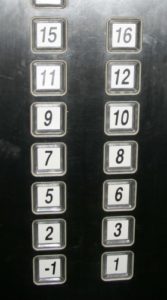
[Creative Commons; from Wikipedia]
Chinese phone numbers
Phone numbers are easy to read and write, and to say. We just need to read out each digit one by one.
However, the character for one “Yi1” sounds a bit like “Qi1” over the phone, so is often replaced with “Yao1”.
Chinese dates
Chinese dates are very straightfoward, and usually written yyyy年mm月dd日
One point worth mentioning is that in Taiwan, they take year 1 as 1911 (the year of the founding of the Republic), so add 1911 to whatever the number is to get the date in the Western calendar. For example year 95 = 1911+95 = 2006, and so on.
Chinese Percentages
These are easy; written almost exactly like English “34%” for example or like “百分之X” (bai3fen4zhi1X meaning “X of one hundred parts”). If you can count, you can do percentages.
Chinese Fractions
Again, these are very easy; usually written just like in English with the same dividing line (3/5 for example) we use in English. Pronounced as “3 parts of 5” with the old character for “of” (三分之五 – San1fen4zhi1wu3 in my example).
Chinese finger counting
There are symbols you can use with one hand to count up to ten in Chinese. Many Chinese speakers assume they are internal and will make the symbols to try and help non-Chinese speakers, but actually we only go as far as 5 in English. So here are the extra finger signs, which are worth learning if you will be visiting China.
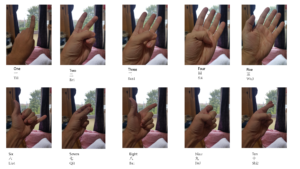
Part 2 – Advanced Chinese Numbers for Translators
Two written forms of Chinese numbers
Since simple characters like 一 (one) can easily be misread, Chinese also uses more formal numbers which contain many more strokes and are much easier to distinguish. In Chinese the regular numbers are usually referred to as “little writing”, and there is another set, very important for translators, called in Chinese “big writing”.

You will often see translators bizarrely translating the name of the big writing numbers as “capital letters” which is clearly wrong but very common. I notice that the Wikipedia article on Chinese numbers refers to them as “financial”, which is a good translation, but not totally correct. They are not always used exclusively for financial documents, and indeed there are financial documents which will use regular numbers, and general documents which use Chinese financial numbers.
Generally I like to use terms like “short set” and “written set”, or “full set” and such similar terms to distinguish the two. On contracts, when a number is written in both forms in the Chinese, I would normally translate into numerals and the written form of the numbers in English for clarity.
| Value | Regular form (Traditional) | Extended (financial Form) (Traditional) | Regular form (Simplified) | Extended (financial Form) (Simplified) | Pronunciation | Comments |
|---|---|---|---|---|---|---|
| 0 | 〇 | 零 | 〇 | 零 | ling2 | This can be pronounced "dong4" which means cave or hole in military radio communications. |
| 1 | 一 | 壹 | 一 | 壹 | Yi1 | Often pronounced as "yao1" on radio and telephone calls; the character for "yao1" is 幺 |
| 2 | 二 | 貳 | 二 | 贰 | Er4 | |
| 3 | 三 | 叄 | 三 | 叁 | San1 | |
| 4 | 四 | 肆 | 四 | 肆 | Si4 | |
| 5 | 五 | 伍 | 五 | 伍 | Wu3 | |
| 6 | 六 | 陸 | 六 | 陆 | Liu4 | |
| 7 | 七 | 柒 | 七 | 柒 | Qi1 | Can be pronounced as 拐 (guai3) in military radio communications. |
| 8 | 八 | 捌 | 八 | 捌 | Ba1 | As above can be pronounced "杯" (bei1) |
| 9 | 九 | 玖 | 九 | 玖 | Jiu3 | As above can be pronounced "勾" (gou1) |
| 10 | 十 | 拾 | 十 | 拾 | Shi2 | Very occassionally you will see the character 什 (shi2) but this can easily be changed to 1,000 see below so is avoided these days. |
| 100 | 百 | 佰 | 百 | 佰 | Bai3 | |
| 1,000 | 千 | 仟 | 千 | 仟 | Qian1 |
Numbers found only in the written character set
Some numbers are used for numbers that are used exclusively in the written character set; see the below table.
| Value | In regular written set | In formal written set (simplified) | In formal written set (traditional) | Comments |
|---|---|---|---|---|
| 20 | 二十 | 廿 | 廿 | Nian4 |
| 30 | 三十 | 卅 | 卅 | Sa4 |
| 40 | 四十 | 卌 | 卌 | |
| 200 | 二百 | 皕 | 皕 | This character wasn't in either of my two main reference dictionaries but I could find several entries about it online; I believe it's pronounced "bi4"; hardly ever used |
Converting between written numbers and digits
Frequently documents such as bank statements will contain large numbers written in Chinese characters, and I have to calculate the equivalent form in English numbers. To do this can be complex, but here are some tools I find useful:
| 1,000,000,000,000 | 100,000,000,000 | 10,000,000,000 | 1,000,000,000 | 100,000,000 | 10,000,000 | 1,000,000 | 100,000 | 10,000 | 1,000 | 100 | 10 | 1 |
| 亿 | 千万 | 百万 | 万 | 千 | 百 | 十 | ||||||
| trillion | hundred billion | ten billion | billion | hundred million | ten million | million |
I would write the number into this table and it helps ensure the correct totals. If a number isn’t mentioned I would assume it is a zero, and only write those numbers which are specifically mentioned. A couple of examples will help clarify further.
Concrete Examples
Here’s a screenshot of a business license which I translated. I’ve deleted some data to retain anonymity:
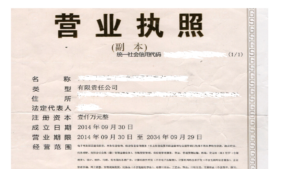
We can see the registered capital is: 壹仟万元正
Let’s start with the easy bit, 正 means “exactly, so we don’t need anything after the decimal point”. 元 means “yuan” (note that it doesn’t take a capital Y despite virtually everyone assuming it does take one; check the style guide of the FT or the Economist). So we can simplify to 壹仟万.
Putting it into the above table we get
| 1,000,000,000,000 | 100,000,000,000 | 10,000,000,000 | 1,000,000,000 | 100,000,000 | 10,000,000 | 1,000,000 | 100,000 | 10,000 | 1,000 | 100 | 10 | 1 |
| 亿 | 千万 | 百万 | 万 | 千 | 百 | 十 | ||||||
| trillion | hundred billion | ten billion | billion | hundred million | ten million | million | ||||||
| 1 |
We can see easily that we’ve got “1” unit of ten million; so it’s just written as “ten million” or “10,000,000” yuan.
Please note I’ve put a couple of deliberate errors (small ones that won’t be a problem for readers) into the text as my content keeps getting stolen. If you want to quote anything, might be worth contacting me first so I can check what you want to say is correct.